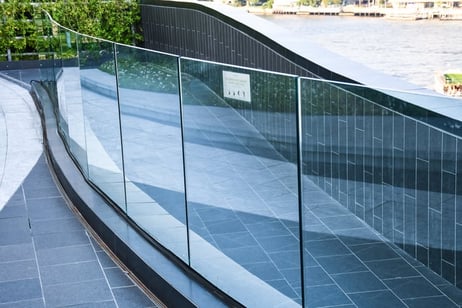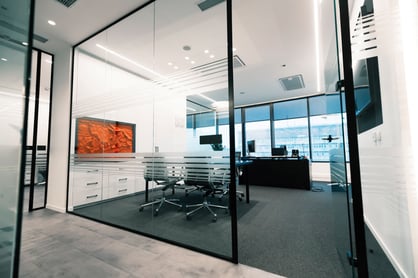|
In this guide, we explore glass tempering and its many uses in commercial projects. We cover (click text to jump to section):
|
Want to take this guide to go? Download it here:

Glass can elevate nearly any space.
A glass shower makes a bathroom feel elegant. A glass staircase gives a home a luxurious look. Glass walls give an office a modern and warm ambiance.
In each of these cases, not just any glass will do. Safety is of the utmost importance. Annealed glass, or traditional glass, is quite dangerous to use in places where people will interact with the glass.
Tempered glass is a strong and safer choice. Read on to see why:
What is Tempered Glass?
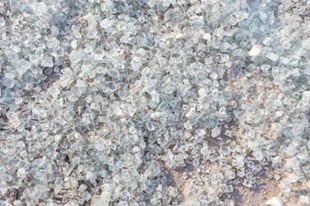
Tempered glass – also known as toughened glass – is used where traditional glass isn’t strong enough.
Tempering strengthens glass 4-5x stronger than standard annealed glass, making it much more resistant to impact. Tempered glass breaks into small, pebble-like pieces instead of sharp, dangerous shards. While these pebbles can still cause injury, they limit the risk of deep lacerations that broken annealed glass poses. The thermal manufacturing process that creates tempered glass makes the final glass heat resistant – a property not seen in standard glass.
|
DISCLAIMER: Tempering glass does not ensure that it will never break, but it will break in accordance with ASTM and ANSI standards. |
Commercial Projects: Where Tempered Glass Fits In
Tempered glass is used where safety is paramount. Building codes often require tempered glass to be used in windows and glass walls in public spaces to minimize injury if the glass breaks.
Tempered glass is often found in commercial areas with heavy foot traffic as well as places in the home, including:
 Skylight windows
Skylight windows- Shower doors and enclosures
- Glass doors for tubs
- Furniture
- Glass cases
- Customer service windows
- Windows for ground-level storefronts
- Railings
- Entryway glass
- Glass partitions
Want a quick primer about
tempered glass to share with your clients?
Download our Glass Tempering 101 page:
Tempered Glass Shapes and Fabrication
 Do you need glass for a uniquely shaped space? Tempered glass can be shaped in several ways. Popular shapes for commercial applications include:
Do you need glass for a uniquely shaped space? Tempered glass can be shaped in several ways. Popular shapes for commercial applications include:
- Squares
- Rectangles
- Parallelograms
- Trapezoids
- Half moons
In addition to standard geometrical shapes, tempered glass can be shaped into most free-form shapes.
If you’re looking to enhance the aesthetic of your glass, tempered glass can be fabricated using:
- Edgework
- Polishing
- V-grooving
All fabrication needs to be done before tempering the glass. Trying to fabricate after tempering can weaken the glass, causing it to break or fail.
Advantages & Disadvantages of Glass Tempering
Tempered glass is beneficial for several applications, especially in places where glass faces heavy wear and tear. While it has many advantages, it isn’t the perfect fit for all applications.

Advantages
- Tougher: Tempering makes glass up to 5x stronger than regular annealed glass. It can stand up against high winds and direct hits and is often laminated and used in windows in areas where hurricanes are common.
- Heat resistant: Tempered glass can withstand temperatures up to 470° Fahrenheit, making it an excellent choice for kitchen appliances and other places where glass is exposed to high temperatures.
- Clarity: Tempering does not negatively affect glass clarity, making it a perfect choice for display cases, windows, and glass doors.
- Versatility: Tempered glass is used in several applications. Tempered glass can be fabricated in several ways to meet the needs of a project. As well, many types of patterned glass can be tempered.
- Scratch resistant: While not scratch-proof, the thermal tempering process makes it more resistant to scratches than regular glass.
Disadvantages
- No alterations after tempering: Tempered glass can’t be resized, cut, or shaped after tempering. Doing so may seriously affect the integrity of the glass.
- Not meant for security on its own: While tempered glass is much stronger than conventional glass, a single blow makes the entire glass pane fall apart, allowing intruders easier entry.
- Expense: Each piece of tempered glass must be custom manufactured because it can’t be adjusted after the tempering process. This also makes replacements expensive, since even a small blow can make the whole window break.

How is Tempered Glass Made?
Tempering requires heating a glass pane using a tempering oven and then cooling it under high pressure.
This process deliberately places stress on the glass. This stress produces tension that is compressed and spread to the outer edges of the glass, giving panes their final strength.
A Closer Look at Glass TemperingThe glass tempering process comprises five steps:
|
1. Cutting
The glass is cut into the desired shape. At New Angle Beveling, the maximum size is 86” x 144” and our minimum is 9” diagonal, which varies depending on the width and height. |
2. Inspection
The glass is inspected for any bubbles or cracks that could cause problems in the tempering process. The glass is exposed to extreme temperatures during the tempering process. Defects may weaken the glass. |
3. Removal of Contaminates & Rough Edges
Sharp edges are smoothed with sandpaper or a gentle abrasive. Fabrication, such as edging or V-grooving can also happen at this step. The glass is then washed to ensure its free of any grains of glass or dirt that could weaken its tempered state. |
4. Extreme Heating
The glass is fed into a tempering oven where it is exposed to heat around 620° Celsius or 1,148° Fahrenheit. |
Tempered Glass vs Laminated Glass: Choosing the Right Safety Glass
Tempered and laminated glass fill many of the same applications. For instance, both types of glass are often used in commercial doors. However, in some instances, laminated glass is a better choice for security and safety options.
Laminated glass is created by bonding a clear layer of plastic (usually polyvinyl butyral – PVB) between two or more glass panes. The additional layers strengthen the glass against heavy blows. The middle layers hold the glass together should the glass break.
Laminated Glass Benefits
Laminated glass is often installed in high-traffic public spaces because it stays together when broken. Laminated glass is found in many of the same applications as tempered glass, except for shower enclosures. In some coastal municipalities where hurricanes are common, local building codes require laminated glass windows to be installed in buildings.
While laminated and tempered glass are used for safety, only laminated is considered security glass. It’s installed in places like storefront windows and doors or display cases to give the benefit of time. The interlayer makes the glass harder to break through, meaning it could be several minutes before an intruder can gain access. The time it takes to break the window is often a deterrent for criminals looking for a quick smash-and-grab. Laminated glass is often rated for the amount of time it withstands blows before being broken through.
|
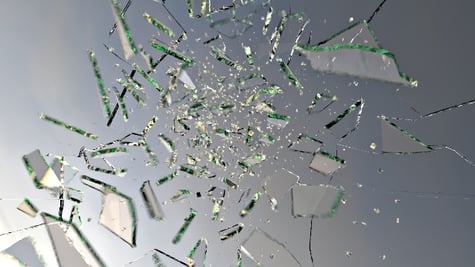 Tempered Glass vs Heat Strengthened Glass
Tempered Glass vs Heat Strengthened Glass
Tempered glass is not to be confused with heat-strengthened glass. Both glass types are heat treated and force-cooled. However, heat-strengthened glass is not as strong as tempered glass. Heat-strengthened glass is often used when glass needs to withstand wind pressure or thermal stress, but the strength of tempered glass isn’t required.
Heat-strengthened glass undergoes the same heating process as tempered glass but is cooled more slowly. This gives the glass a lower compression strength, roughly 2x stronger than annealed glass. Heat-strengthened glass also breaks similarly to annealed glass and is less prone to surface defects than tempered glass.
How to Tell If Glass is Tempered
It’s easy to tell if glass is tempered when it breaks. However, there are 5 simple ways to determine if glass has been tempered without breaking it:
- Examine the edges
- Spot Imperfections
- Look for a stamp
- View through polarized sunglasses
- Score a line
1. Examine the Edges

Tempered glass has smooth and rounded edges. Any sharpness is smoothed before tempering. While not every glass with smooth edges is tempered, a sharp or rough edge is a clear sign that a sheet of glass is not tempered.
2. Spot Imperfections
While not glaring, tempered glass will feature slight imperfections. Small distortions or bending in the glass are possible from tempering. Glass becomes pliable when exposed to the high heat of tempering. The tongs that handle the glass sheets can leave slight impressions. Tiny marks may also be seen as a result of small particles scratching the glass during the process.
3. Look for a Stamp

Tempered glass should have a stamp on it that proves it’s tempered. The stamp is usually displayed in a corner of the sheet, showing the name of the manufacturer and noting that it is authorized by the Consumer Products Safety Commission.
4. View Through Polarized Lenses
Tempered glass has a giveaway you can’t see with the naked eye. However, you will see spots or lines stretching across the pane by examining the glass in the sunlight while wearing polarized lenses. These are created by the machine rollers used in the heating process.
5. Score a Line
Tempered glass is cut before tempering. Cutting tempered glass can ruin the integrity of the pane or cause it to break. When scoring the glass with a glass cutter, tempered and annealed glass act differently. Tempered glass will create an uneven surface with material flaking off. Scoring annealed glass will create a neat and clean line.
Where is Tempered Glass Necessary
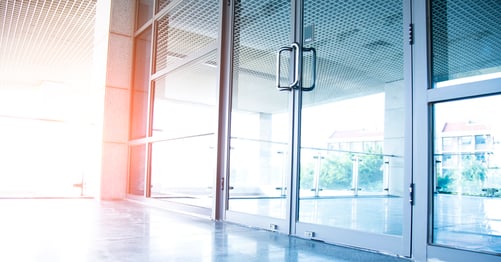
When working on a commercial project, you may be required to use tempered glass in many places. Check with your local building code enforcement office for requirements. Common places tempered glass is required include:
- Doors
- Near doors
- Windows
- Guardrails and railing
- Wet locations
- Near stairs and ramps
- Near the bottom of the stairs
- If you're in doubt or have any safety considerations, use tempered glass
Tempering Types of Shower Glass for Safety & Aesthetics
One of the most common uses for tempered glass is in the shower. Because it breaks into tiny pebble-like fragments, tempered glass is safer to be around when broken than other types of glass.
Annealed glass breaks into dangerous shards. Laminated glass with a PVB interlayer is not used because the interlayer could deteriorate after prolonged exposure to moisture.
Building codes require tempered glass for shower enclosures and doors. Most glass manufacturers only sell tempered glass for this application.
Types of Shower Glass for Tempering
Although tempered glass is the only glass typically used for showers, that doesn’t necessarily limit your creativity.
The most common tempered glasses used for transparent shower walls and doors include:
- Clear glass: Clear glass does have a slight greenish tint that becomes more pronounced in thicker pieces – you’ll especially notice it when looking at a pane’s edges.
- Low-iron glass: This glass is virtually colorless and is 6% more transparent than standard glass. It picks up colors along its edges from the surrounding environment.
- Patterned glass: There are lots of patterns from which to choose. Some bend light to distort transparency, while others create a textured appearance that obscures the view. Not all patterned glass is temperable. Acid etched, Cast, and Rain are common patterns that can be tempered.
- Coated glass: An invisible coating is bonded to the inward-facing side of the shower glass. The coating protects the glass from soap scum, residue, minerals, and cleaning products.
Maintaining Shower Safety Glass

Glass shower enclosures can make a bathroom stand out. However, the apparent build-up will make the bathroom appear dirty if the glass isn’t cleaned regularly. Luckily, glass is one of the easiest materials to clean because all the build-up is only at the surface level.
There’s no need for fancy cleaners. Regular glass-cleaning products with ammonia or bleach and a wet sponge or microfiber cloth are all that’s needed to keep glass looking new. Even a mix of water and vinegar can keep glass clean.
Using the wrong products and cleaning materials can damage glass. Be sure the cleaning product you use is approved for glass use.
Steer clear of:
- Abrasive cleaning products, such as bleach powders
- Hydrofluoric and phosphoric acids
- Brushes
- Scouring pads
Taking care of your tempered shower glass is easy!
Glass Tempering Details You Should Tell Your Commercial Glass Company
 Tempered glass can be shaped, sized, and fabricated to your liking before tempering. However, you want your tempered glass manufacturer to have the exact details of your project. Small errors in measurements, thickness, or cutout placements can make a tempered glass pane unusable, costing you time and money.
Tempered glass can be shaped, sized, and fabricated to your liking before tempering. However, you want your tempered glass manufacturer to have the exact details of your project. Small errors in measurements, thickness, or cutout placements can make a tempered glass pane unusable, costing you time and money.
Here are three details your want to provide to your commercial glass company:
- Glass Type
- Detailed renderings
- Edgework
Glass Type
There is an ideal glass type for nearly every project. Ask your manufacturer if you need help deciding what kind of glass would work best.
Detailed Renderings
Project details are important since tempered glass can’t be modified after tempering. Glass manufacturers need to know how the glass will be used, the exact dimensions, and precise fabrication instructions.
It’s best to send detailed renderings to your glass manufacturer that give as much detail as possible, including:
- Precise measurements, including glass thickness
- Exact locations of cutouts, holes, or notches
- Manufacturer specs on hardware to be attached
Edgework
 Edgework occurs right before a glass pane is superheated and quickly cooled for tempering.
Edgework occurs right before a glass pane is superheated and quickly cooled for tempering.
While glass edging removes sharp, jagged edges where cuts were made, it also adds a touch of sophistication to a finished piece.
Popular edgework styles include:
- Flat edge
- Pencil edge
- Beveled edge
- O.G. edge
- Bullnose edge
- Triple pencil edge
Polishing is an additional finishing option for shaped tempered glass that enhances a pane’s reflectivity. V-Grooving can also be incorporated to enhance the appearance of the piece.
A Note On Hole Placement
If you have holes in your glass project, please remember that your manufacturer may use a saw or relief cut when holes are too close to the edge for a corner to ensure glass ensures the tempering process. Please refer to these specifications (click on the images to enlarge):
Glass Tempering for Your Commercial Project
Providing your glass manufacturer with the correct information allows them to quickly begin work on the glass you need for your project.
Production time can vary based on the complexity of work and work already scheduled for other customers. It’s best to talk with the tempered glass manufacturer about current lead times to shape and temper a piece of glass.
Interested In Partnering With New Angle Beveling?
We’ve worked on commercial glass projects ranging from creating custom insulated glass units and tempered glass pieces to heavy glass shower enclosures and glass staircases. Our experience and attention to detail make us a great partner for your project. Contact us and let’s get to work! |











